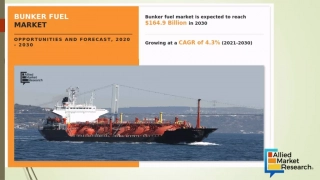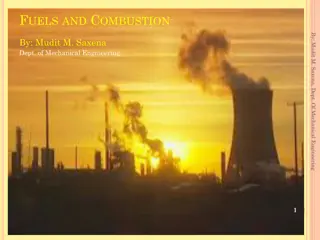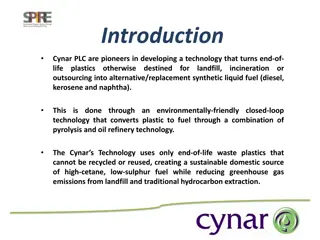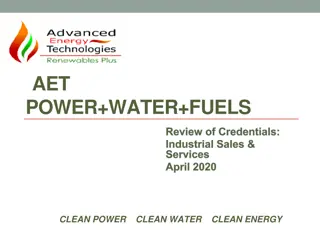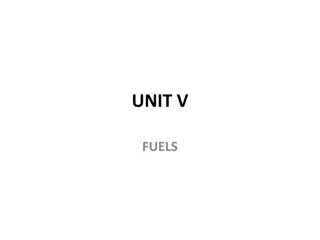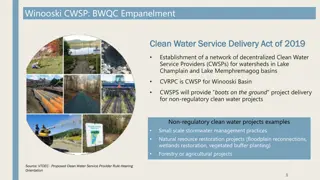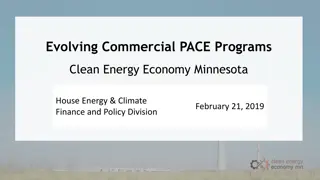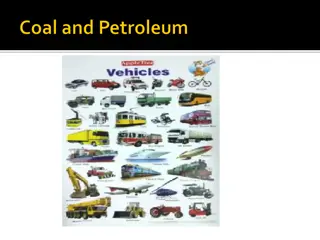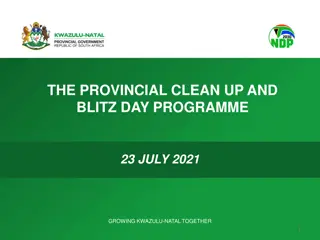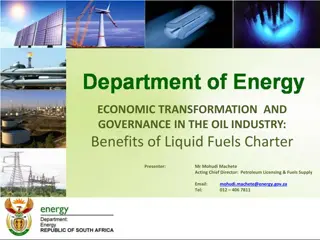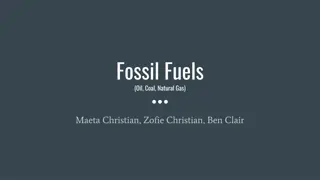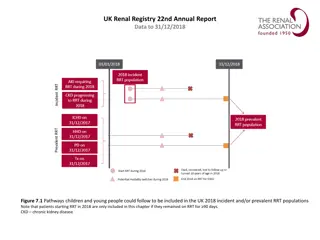Clean Fuels Forecast Review - August 22nd, 2023 Summary
Reviewed in this forecast are the Committee's discussions on major policy changes and proposals, including Advanced Clean Cars I & II, Clean Trucks Plan/Rules, Bipartisan Infrastructure Law, Inflation Reduction Act, Washington Clean Fuel Standard, and Portland Renewable Fuel Standard. The Oregon Department of Transportation's (ODOT) fuel consumption forecast shows changes in gasoline and diesel consumption percentages year-over-year. Reported volumes forecast various fuel types like motor gasoline, ethanol, diesel, biodiesel, renewable diesel, on-road electricity, off-road electricity, natural gas, and liquefied petroleum gas. Future projections indicate changes in motor gasoline and ethanol consumption, as well as blend rates. The forecast also covers total diesel consumption estimates. Referencing data from ODOT and EIA, the presentation displays trends for 2016-2022 and outlines the expected figures for 2023 and 2024.
Download Presentation

Please find below an Image/Link to download the presentation.
The content on the website is provided AS IS for your information and personal use only. It may not be sold, licensed, or shared on other websites without obtaining consent from the author. Download presentation by click this link. If you encounter any issues during the download, it is possible that the publisher has removed the file from their server.
E N D
Presentation Transcript
Clean Fuels Forecast Review August 22nd, 2023 Office of Economic Analysis
2023 Forecast Review AGENDA Committee Business Major Policy Changes/Proposals ODOT Fuel Forecast Reported Volumes Forecast Carbon Intensities for Biofuels Credit/Deficit Forecast Supply Forecast Discussion Next Steps Adjourn 2
Major Policy Changes/Proposals Advanced Clean Cars I & II Clean Trucks Plan/Rules Bipartisan Infrastructure Law Inflation Reduction Act Washington Clean Fuel Standard Portland Renewable Fuel Standard See OEA Issue Brief providing overview of each policy. 4
ODOT Fuel Consumption Forecast 15.0% Gasoline Diesel 10.0% Percent Change Y/Y 5.0% 0.0% -5.0% -10.0% -15.0% Source: Oregon Department of Transportation 5
Reported Volumes Forecast Motor Gasoline Ethanol Diesel Biodiesel Renewable Diesel On-Road Electricity Off-Road Electricity Natural Gas Liquified Petroleum Gas 6
2016-22 Motor Gasoline (Y/Y change) EIA Pacific Outlook ODOT Gasoline Forecast Clean Fuels Program 2020 -10.5% -12.8% -19.1% Ann. Growth 2021 3.7% 8.5% 7.2% 2022 -5.1% -2.2% 0.0% 2023F -0.8% -1.7% -0.9% 2024F -1.8% 0.2% 0.2% -1.2% -1.0% Motor Gasoline (CFP Reported, quarterly) 500 450 400 Millions of Gallons 350 300 250 200 7
Ethanol (Y/Y change) EIA National Outlook ODOT Gasoline Forecast Clean Fuels Program 2020 -12.3% -12.8% -18.5% 2021 8.2% 8.5% 10.7% 2022 2.4% -2.2% -4.6% 2023F -0.2% -1.7% 2.5% 2024F 2.4% 0.2% -0.9% Blend Rate 10.07% 10.41% 9.92% 10.26% 10.15% Ethanol Blend Rate Ethanol (CFP Reported, quarterly) 14.0% 55 12.0% 50 10.0% Millions of Gallone 8.0% 45 6.0% 40 4.0% 35 2.0% 30 0.0% 2023 Q1: Blend rate = 10.79 percent 8
2016-22 Total Diesel (Y/Y change) EIA Pacific Outlook ODOT Diesel Forecast Clean Fuels Program 2020 -13.0% 9.5% -6.0% Ann. Growth 2021 4.1% 8.6% 9.8% 2022 2.8% -2.5% 7.5% 2023F 3.3% -0.2% -4.1% 2024F -1.5% -0.3% -0.3% 1.8% 2.6% Total Diesel (CFP Reported, quarterly) 220 200 Millions of Gallons 180 160 140 120 100 9
Biodiesel (Y/Y change) EIA National Outlook ODOT Diesel Forecast Clean Fuels Program 2020 -20.7% 9.5% 13.9% 2021 -5.6% 8.6% 10.8% 2022 -6.0% -2.5% 7.6% 2023F -5.8% -0.2% -2.2% 2024F 15.4% -0.3% 3.7% Blend Rate 9.1% 9.2% 9.2% 9.4% 9.8% Biodiesel/Renewable Diesel Blend Rate Biodiesel (CFP Reported, quarterly) 25.0% 26 Biodiesel Renewable Diesel 24 20.0% 22 20 Millions of Gallons 15.0% 18 16 10.0% 14 12 5.0% 10 8 0.0% 2023 Q1: Blend rate = 9.17 percent 10
Renewable Diesel (Y/Y change) EIA National Outlook ODOT Diesel Forecast Clean Fuels Program 2020 13.1% 9.5% 6.8% 2021 2022 2023F 19.5% -0.2% 63.1% 2024F 1.6% -0.3% 11.1% 111.0% 8.6% -43.9% 100.9% -2.5% 376.7% Blend Rate 2.3% 1.2% 5.3% 9.0% 10.0% Biodiesel/Renewable Diesel Blend Rate Renewable Diesel (CFP Reported, quarterly) 25.0% 25 Biodiesel Renewable Diesel 20.0% 20 15 Millions of Gallons 15.0% 10 10.0% 5 5.0% 0 -5 0.0% 2023 Q1: Blend rate = 12.26 percent 11
Total Electric Vehicles 300,000 Current forecast Prior Forecast 250,000 200,000 150,000 100,000 50,000 0 Source: Oregon Department of Transportation 12
On-road Electricity (Y/Y change) EIA Pacific Outlook ODOT Electric Vehicle Clean Fuels Program 2020 -6.5% 22.4% 27.6% 2021 35.7% 25.9% 27.0% 2022 34.1% 32.2% 48.1% 2023F 26.3% 36.3% 17.7% 2024F 24.5% 36.0% 38.0% Total On-Road Electricity (CFP Reported, quarterly) Non-Res KWh per Vehicle 180 4.5 160 4.0 140 3.5 Millions of Gallons 120 3.0 100 2.5 80 2.0 60 1.5 40 1.0 20 0.5 0.0 0 Residential KWh/vehicle/year = 3,102.5 13
Off-road Electricity (Y/Y change) EIA Pacific Outlook Clean Fuels Program 2020 -6.5% 45.6% 2021 35.7% 53.9% 2022 34.1% 27.4% 2023F 26.3% 11.4% 2024F 24.5% 30.0% Total Off-Road Electricity (CFP Reported, quarterly) 3.5 3.0 Millions of Gallons 2.5 2.0 1.5 1.0 0.5 0.0 14
Natural Gas (Y/Y change) EIA Pacific Outlook Clean Fuels Program 2020 -20.2% -0.7% 2021 71.1% 15.8% 2022 -17.1% 3.9% 2023F 9.5% 9.5% 2024F 13.4% 15.0% Biogas Blend Rate 88.7% 91.4% 94.0% 96.0% 97.5% Biogas Blend Rate Natural Gas (CFP Reported, quarterly) 100.0% 1.6 90.0% 1.4 80.0% 70.0% 1.2 Millions of Gallons 60.0% 1.0 50.0% 0.8 40.0% 0.6 30.0% 0.4 20.0% 0.2 10.0% 0.0 0.0% 2023 Q1: Blend rate = 99.20 percent 15
Liq. Petroleum Gas (Y/Y change) EIA Pacific Outlook Clean Fuels Program 2020 -47.3% -28.2% 2021 17.3% 65.7% 2022 12.8% 32.6% 2023F 4.2% 33.2% 2024F 0.2% 31.6% LPG Blend Rate 11.8% 20.7% 28.5% 35.0% Liquid Petroleum Gas Blend Rate Liquified Petroleum Gas (CFP Reported, quarterly) 100.0% 1.6 90.0% 1.4 80.0% 70.0% 1.2 Millions of Gallons 60.0% 1.0 50.0% 0.8 40.0% 0.6 30.0% 0.4 20.0% 0.2 10.0% 0.0 0.0% 2023 Q1: Blend rate = 23.18 percent 16
Table 1: Clean Fuels Forecast - Reported Volumes annual %ch vs. 2022 2021 2022 2023F 1,341.3 153.3 10.3% 1,494.6 2024F 1,345.2 152.0 10.2% 1,497.2 (Mil. gallons, percent) Conventional Gasoline Ethanol Ethanol Blend Rate Blendstock 1,351.4 157.0 10.4% 1,508.4 1,358.9 149.7 9.9% 1,508.6 -0.5% 0.8% -0.4% Fossil Diesel Biodiesel Biodiesel Blend Rate Renewable Diesel Renew diesel Blend Rate Total Diesel 736.2 75.9 9.2% 9.8 1.2% 821.8 755.3 81.6 9.2% 46.6 5.3% 883.6 691.1 79.8 9.4% 76.0 9.0% 846.9 677.4 82.8 9.8% 84.5 10.0% 844.7 -5.3% 0.7% 34.6% -2.2% Electricity (on-road) Electricity (off-road) 4.7 5.0 6.9 6.3 8.1 7.1 11.2 9.2 27.5% 20.3% Fossil Natural Gas Biogas Biogas Blend Rate Total Natural Gas 0.3 3.5 0.2 3.7 0.2 4.2 0.1 4.9 -27.7% 14.3% 91.4% 94.0% 96.0% 97.5% 3.8 4.0 4.3 5.0 12.2% Fossil LPG Bio LPG LPG Blend Rate Liquified Petroleum Gas 2.2 0.3 2.6 0.7 3.1 1.2 3.7 2.0 19.9% 72.3% 11.8% 20.7% 28.5% 35.0% 2.4 3.2 4.3 5.7 32.4% 17 On-road electricity includes a calculation for residential charging.
Carbon Intensities for Biofuels Ethanol Biodiesel Renewable Diesel 18
Ethanol Carbon Intensity 65 63.3 62.7 60.9 60 58.1 Weighted Average 54.8 53.7 55 53.4 51.0 50.0 50 45 40 19 Lower bound scenario: 36.0
Biodiesel Carbon Intensity 55 51.9 50 47.2 Weighted Average 45.2 45 42.1 41.8 41.5 41.0 40.5 38.7 40 35 30 20 Lower bound scenario: 21.6
Renewable Diesel Carbon Intensity 45 39.2 39.1 38.8 40 38.5 37.0 Weighted Average 33.6 35 31.5 30.1 30 25 20 21 Lower bound scenario: 32.5
Parameters for 2024: Carbon Intensity Target Energy Density Carbon Intensity Assumption Gasoline Ethanol Diesel Biodiesel Renewable Diesel Electricity KWh/vehicle (res) EERelect EER_NG Natural Gas Biogas Liq. Petroleum Gas 122.48 81.51 134.48 126.13 129.65 3.60 3103 3.40 0.90 134.48 134.48 89.63 90.21 90.21 90.84 90.84 90.84 90.21 100.14 50.00 100.74 40.50 38.50 0.00 90.84 90.84 90.21 79.98 2.50 48.00 22
Credit / Deficit Summary 2022 -1,210,616 -718,117 -1,928,734 2023F -1,401,261 -787,068 -2,188,329 2024F -1,636,062 -901,879 -2,537,941 Deficits Gasoline Diesel Deficit Total Credits Ethanol Biodiesel Renewable Diesel Electricity, on-road Electricity, off-road Natural Gas Liquified Petroleum Gas 507,926 543,579 333,424 221,021 167,528 33,670 5,338 1,812,487 520,874 507,548 505,154 301,595 163,119 55,378 13,415 2,067,084 498,056 525,580 573,175 421,551 212,609 51,810 21,503 2,304,284 Credit Total Net Credits/Deficits Beginning Banked Credits Total Net Credits/Deficits -116,247 765,491 649,244 -121,245 649,244 527,999 -233,657 527,999 294,342 23
Bio-Fuel Supply Statutory directive regarding supply (ORS 468A.272): The fuel supply forecast shall include, but need not be limited to, the following with reference to the next compliance period of the clean fuels program: An estimate of the potential volumes of gasoline, gasoline substitutes a) and gasoline alternatives and diesel, diesel fuel substitutes and diesel alternatives available to Oregon; In developing the estimate required under subsection (1)(a) of this section, the division shall consider, but need not be limited to considering: Constraints that may be preventing access to available and cost-effective a) low carbon fuels by Oregon, such as geographic and logistical factors, and alleviating factors to the constraints; and b) The existing and future vehicle fleet in Oregon. 24
EPA Renewable Fuel Standard Program - Reported Production (millions of gallons) Ethanol 2018 2019 2020 2021 2022 2023 Est. 14,487.9 Domestic Importer 14,985.8 92.0 15,077.8 0.7% 1,855.5 175.1 2,030.6 -1.0% 305.5 309.8 615.3 2.1% 214.4 14,746.4 213.4 14,959.7 -0.8% 1,713.8 184.7 1,898.5 -6.5% 492.1 420.4 912.5 48.3% 317.0 11.1 51.8 24.4 404.4 32.4% 12,870.7 197.2 13,067.9 -12.6% 1,824.9 209.5 2,034.4 7.2% 533.5 435.5 969.0 6.2% 388.1 24.3 80.9 10.6 503.9 24.6% 14,137.7 72.9 14,210.6 8.7% 1,704.6 208.5 1,913.1 -6.0% 845.4 471.0 1,316.4 35.9% 452.4 33.0 81.0 14,431.4 94.6 14,526.1 2.2% 1,619.9 240.3 1,860.3 -2.8% 1,454.5 446.4 1,900.9 44.4% 547.1 30.6 84.1 11.9 Total Ethanol Y/Y change Biodiesel 14,499.9 -0.2% 1,726.1 444.9 2,171.0 16.7% 2,373.5 488.5 2,862.0 50.6% 715.3 Domestic Importer Total Biodiesel Y/Y change Renewable Diesel Domestic Foreign Total Renewable Diesel Y/Y change Renewable CNG Domestic Importer Domestic Importer 8.3 55.2 27.5 305.4 25.9% 5.9 50.8 29.7 801.7 20.0% Renewable LNG 3.1 6.4 Total Natural Gas Y/Y change Propane Y/Y change 569.5 13.0% 668.2 17.3% Domestic 0.7 4.2 4.3 4.6 4.4 5.6 537.7% 2.3% 6.6% -5.1% 28.4% Note: 2023 estimates based on year-over-year growth through first six months, except where varying arrival rate dictates otherwise. https://www.epa.gov/fuels-registration-reporting-and-compliance-help/rins-generated-transactions 25
Potential Supply Comparison Certified Capacity* (millions of gallons) Suppliers 2024 Proj. Volume (millions of gallons) Percent of Capacity Fuel Type Ethanol 2,403 31 152 6.3% Biodiesel 1,188 26 83 7.0% Renewable Diesel 2,041 9 84 4.1% Natural Gas 85 11 5 5.7% * 2023 suppliers and reported capacity 26
Comparison of Carbon Credit Prices $250 $200 $150 $100 $50 Oregon California $0 27
Next Steps Distribute draft forecast document by September 1st. Comments due back by 5:00 September 15th. If necessary, follow-up meeting scheduled for September 18th, 1:30 3:00 (online). 28
Questions or comments: Contact Michael Kennedy Michael.kennedy@das.Oregon.gov (971) 678-5595 Or Mark McMullen Mark.mcmullen@das.Oregon.gov (971) 345-1003 29





